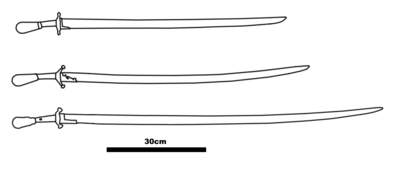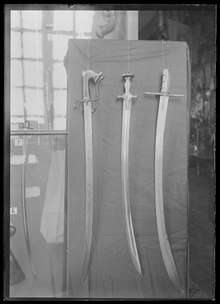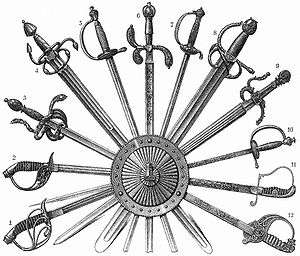Turko-Mongol sabers
These swords were used by the Turkic nomads of the Eurasian steppes primarily between the 9th and 14th centuries.[1][2][3][4] One of the earliest recorded sabres of this type was recovered from an Avar grave in Romania dating to the mid 7th century.[5] Although minor variations occur in size and hilt, they are common enough in design across 5 centuries that individual blades are difficult to date when discovered without other context.
| Turko-Mongol Sabre | |
|---|---|
 | |
| Type | Cavalry Sabre |
| Place of origin | Eurasian Steppes |
| Service history | |
| Used by | Turkic Nomads |
| Production history | |
| Designed | 8th - 14th Century |
| Specifications | |
| Length | 30" - 40" Blade |
These swords measured between 30 and 40 inches in blade length and bore a gentle curve, leading to a pointed tip useful for thrusting. They were designed for use on horseback and neighboring peoples frequently encountered these blades at the hands of Turkic raiders.[2]
A common feature of the hilts was a 'bend' just below the pommel. This is partly due to construction of the pommel and tang and partly a feature interned to aid a mounted warrior swing the weapon at an opponent.[6] The hilt bore short quillions that often swept slightly forward, but could also be straight. Just after this, the hand guard on the forte of the blade lay a feature typically of copper or iron called tunkou in China.[2] This was made as a sleeve of metal to wrap around the blade, designed to aid the sword sealing into the scabbard. Some early tunkou of high status swords were gilded and decorated with patterns.[3] Later swords that descended from these blades bore non functional tunkou that were ornamental and at times just etched onto the blades.
Influence on Later Swords
Chinese Swords: Prior to the 13th century Chinese swords were both single and double edged but were always straight. The Mongol invasion and subsequent Yuan Dynasty brought with it the Turkic influenced curved sabres, which eventually lead to the creation of the Dao family of swords (initially called Peidao).[4] Traces of the Turko-Mongol heritage were notable in the liuyedao, persisting into the Qing dynasty where it retained design elements such as blade shape and tunkou.[7]
Islamic Swords: Early Arab swords were all straight and mostly double edged (similar to european arming swords blades). Although Turko-Mongol Sabres have been found among a turkic slave of the Samanid Empire, straight swords continued to be more popular outside of certain groups (such as the Seljuks) as that was the traditional style of sword the Prophet Mohammad wore.[6] After the Mongol invasion, across the Muslim world, in the 13th century, the curved designs became more popular in particular with the Ottomans in Anatolia.[8] The Ottomans continued to use curved swords, developing them further until they distinguished a distinct heavy-bladed version which would become the Kilij in the first half of the 15th Century. The Mongol style sabers continued to remain in use in Persia until the late 16th century, at which point they developed into the recognizable Shamshir.[9] The Mughul invasion of Afghanistan and India brought these sabres to the subcontinent which developed into the Pulwar and Talwar respectively in the 16th century. While these Islamic blades often retained tunkou showing their Turko-mongol heritage, even by the 15th century the device had become a stylized decorative element.[10]
The Ottoman Yataghan, while not bearing a traditional curved sabre blade, did still bear the tunkou indicating their turko-mongol heritage.[11]
European Swords: Eastern Europe had long had contact with nomadic steppe groups such as the Avars, Alans and Cumans. While Western Europe was still focused primarily on straight bladed longswords and arming swords during the medieval period to combat the heavy armor that was being used in European warfare, the arrival of Turkic warfare, first with the Mongols and secondly with the Ottomans, influenced warfare and armaments in Eastern Europe.
- The Byzantine Army employed a sword called the paramerion, which is considered to be a type of sabre, from the 11th century if not earlier. The Byzantines had close contact with various Turkic steppe peoples, Khazars, Pechenegs, Cumans etc., from which the paramerion may have derived. Later Byzantine images, from the 14th century onwards, show very curved swords with a yelman, that are similar to early examples of the Turkish kilij.[12]
- Russia had an earlier history of straight swords from the earlier viking age, but starting in the 10th century, the Saber was adopted as well.[1] From the 10th through 13th centuries Saber use spread from southeastern Russia and made its way northward. Finds prior to the Mongol invasion show almost, but not quite, as many sabres as straight swords in use in Russia during these three centuries.
- In the Caucasus, the Cossacks developed the Turko-Mongol saber into a distinct version called the Shashka by the 12th century.
- Hungary began to adopt Turkish style light horsemanship and the curved swords in a similar Turkish style, culminating in the Hungarian Hussar, as the prototype for European light Cavalry of the coming centuries.
- Poland too adopted this type of sword design in the Szabla starting in the late 16th century. Indeed, these Hungarian and Polish examples of sword and cavalry would become so effective that the great Powers of Europe would later take from this design in the development of the modern period cavalry sabre which exists in uniform dress of many armies to this very day.
- In Germany, encounters with the encroaching Turks caused modifications of the langes messer which eventually brought about the dusack in the mid 16th Century.
References
- Кирпичников, A.H. (1966). "Old Russian weapons. Vol. 1". ACADEMY OF SCIENCES OF THE USSR INSTITUTE OF ARCHEOLOGY.
- Tom, Philip M. W. (2001). "Some Notable Sabers of the Qing Dynasty at The Metropolitan Museum of Art". Metropolitan Museum Journal. V. 36.
- Inkova, Mariela (2013). "A MEDIEVAL SABRE AND A KNIFE FROM THE EXHIBITION OF THE NATIONAL MUSEUM OF HISTORY IN SOFIA". Acta Militaria Mediaevalia. IX: 63–88.
- "Military sabers of the Qing dynasty | Mandarin Mansion". www.mandarinmansion.com. Retrieved 2019-09-28.
- Cosma, Călin (2018). "Seventh- Eighth-century Swords, Sabres,and Backswords discovered in Transylvania, Maramureș, and the Romanian Banat". Slovenská archeológia. LXVI – 1: 27–48.
- Alexander, David (2001). "SWORDS AND SABERS DURING THE EARLY ISLAMIC PERIOD". Gladius. XXI: 193–220.
- "Of geese and willows | Mandarin Mansion". www.mandarinmansion.com. Retrieved 2019-09-28.
- Zaky, A. Rahman (1961). "Introduction to the Study of Islamic Arms and Armour". Gladius. I: 17–29.
- Khorasani, Manouchehr (2006). "An Introduction to the Persian Sword Shamshir". moshtaghkhorasani.com. Retrieved 2019-09-30.
- Mohamed, Bashir (2008). The Arts of the Muslim Knight. p. 66. ISBN 978-8876248771.
- Samgin, Von Sergey (2016). "A New Hypothesis of the Genesis of the Ottoman Yataghan: the Crimean connection". Waffen-und Kostumkunde. 58: 49–60.
- Dawson, Timothy (2007) Byzantine Infantryman, Eastern Roman Empire c.900–1204, Osprey, Oxford , ISBN 978-1-84603-105-2, p. 25.

